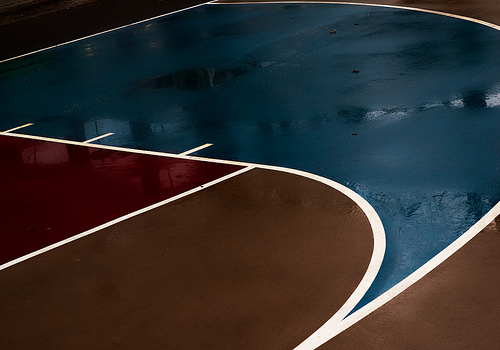- You are here:
- Home »
- Blog »
- Basketball »
- Youth Basketball Court Dimensions
Youth Basketball Court Dimensions
 Photo By: David Goehring
Photo By: David Goehring
You may be surprised to know that basketball courts come in a few different sizes. Unfortunately, there is not a standard set of youth basketball court dimensions, unless they are at the junior high level or more advanced.
This depends on really what level the athletes are playing at. There are set basketball court dimensions for high school, college, and professional levels in the United States.
Most youth leagues will not have their own basketball court to play at, and instead will be playing at a local high school or junior high.
If you know where you will be playing, I would check with that school or location to see if they know the exact dimensions. Most likely they won’t know the exact dimensions off-hand, but if you know what level normally plays there, you should be able to figure it out on your own.
Just because you are playing at a high school, for example, doesn’t mean you will be playing on a regulation high school basketball court. Many high schools have extra baskets, basically set up behind what would normally be the sidelines, so they can run 2 games at once, running sideways or perpendicular to where high school games would be played.
Youth Basketball Court Dimensions
Length – 74 feet*
Width – 42 feet*
Free throw line – 15 feet (from backboard)
Remember, these youth dimensions are not necessarily standard, and you should definitely check with your governing body to see what the specific rules are. If they play on a junior high court, their rules would be the same as what is listed below, but it is tough to get a specific answer with such variety of organizations running games.
If there is a 3-point line, it would normally be 19.75 feet, like junior high and high school, but not every youth league actually has a 3-point line. Again, you will need to check with your governing body.
United States Junior High School Basketball Court Dimensions
Length – 74 feet
Width – 42 feet
3-point line – 19.75 feet (from basket)
Free throw line – 15 feet (from backboard)
This is the smallest standard basketball court you can find in the U.S. High school, NCAA, and the NBA all have a width of 50 feet. The 3-point and free throw line is exactly the same as the high school level. The width of the court is also 10 feet shorter than high school. So, basically, this is just like a high school court, if they chopped 4 feet of of each sideline and 5 feet on each side of the half court line.
United States High School Basketball Court Dimensions
Length – 84 feet
Width – 50 feet
3-point line – 19.75 feet
Free throw line – 15 feet
The high school court is 8 feet wider and 10 feet longer than the junior high court, with the major lines being the same. This may not seem like much, but it can absolutely make a difference to your team.
The high school dimensions are similar to college, the NBA, and the WNBA, except the court is 10 feet longer and the 3-point lines are further from the basket. You can find the dimensions of all levels of basketball at this link.
I know of a couple youth leagues that play tournaments on the smaller court and then play their championship games on the bigger court. If this could happen to your basketball team, I would at least consider trying to get an occasional practice on a high school court.
An extra 10 feet, on every transition in the game, can make a massive difference in testing your players’ conditioning, rhythm, and timing on both offense and defense. It is simply much more challenging on the body to travel 84 feet compared to 74 on each play. While obviously not every player will travel from baseline to baseline on each play, the extra 10 feet is essentially added around halfcourt, making it impossible to avoid.
This also can effect the rhythm and timing of the offense because plays, especially transition offense, are slower to develop because of the extra ground to cover. Your players will also have farther to travel in transition defense. If you go back and forth on different court types, pay extra attention to your teams’ conditioning and fatigue levels. You may need more frequent substitutions.
While there aren’t necessarily any set youth basketball court dimensions, the 74 by 42 size is the most likely size your team will be playing. This is a great size for youth athletes to be able to get plenty of basketball work in without overly challenging their fitness and conditioning levels.

